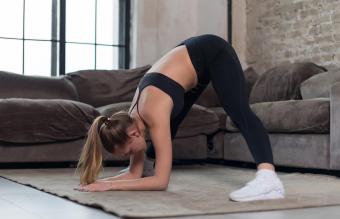
The bird dog exercise involves simple movement that tests your balance and strengthens your core muscles. It is particularly good for strengthening and stretching the lower back.
Instructions for Bird Dog
The standard bird dog exercise begins from a ground position. If your knees are irritated by having weight upon them, double up on the mat or move on to the standing bird dog (explained below). Bird dog can be included within the core portion of your existing strength routine or as a warm up before cardio or even as a cooldown stretch.
- Position yourself on your hands and knees, evenly distributing your weight.
- Keeping your gaze on the ground (to avoid straining your neck), extend your right arm ahead of you and left leg behind you off the mat, reaching as far as you can.
- Hold the reach for three seconds, breathing throughout the entire movement.
- Squeeze your glutes and bend your right elbow and left knee, meeting the two underneath your torso. Hold this squeeze for another three seconds.
- If you need a break, reset here. Otherwise, repeat the reach and squeeze seven more times for a total of eight repetitions.
- Repeat the entire set one the other side with your left arm and right leg.
If you tire easily in this exercise, consider alternating sides to counter the fatigue. If, in particular, your hips begin to fatigue or ache, reset by taking a break in child's pose. Ideally, three sets of eight repetitions on both sides is a good addition to your exercise program, but if you have to work up to this goal incrementally, do so slowly. You'll find your endurance and strength get better as your neuromuscular memory increases.
Modifications for Bird Dog
Bird dog can be done lying prone upon a stability ball; this is an excellent option if the traditional position hurts the knees. If endurance and strength is an issue, modify bird dog to do arms first before moving on to legs. While this modification is not as beneficial to core strength as the original position, it is a good way to work toward the necessary strength and endurance to complete the exercise properly. If the bird dog exercise simply proves too difficult or uncomfortable, it can be done from a standing position instead.
Standing Bird Dog
Bird dog done from a standing position is a strengthening and stabilizing exercise. This can be done with or without hand weights; ankle weights are generally not recommended as they increase the chances for injury.
- Stand on your right leg, pushing your left leg behind you. Keep both legs straight.
- Reach your left arm forward, allowing your torso to lean forward. Keep your spine straight and don't crane your neck up. Your right arm stays by your side.
- Squeeze your glutes and reach, lengthening your body. Hold for three seconds. Visualize your fingers and toes reaching for opposite walls. If you need help with balance, your hand can rest on a wall for stability.
- Bend your right knee and your left elbow and meet them in front of your torso, squeezing for three seconds. Repeat this movement for a total of eight repetitions.
- Repeat on the other side. Try to complete three sets of eight repetitions on each side.
Benefits of Bird Dog
Physical therapists often suggest bird dog for patients who need to strengthen their lower backs to alleviate lower back pain because this exercise targets the lower back. It also strengthens the glutes (especially when the exerciser squeezes throughout the movement), and the rest of the core. It's also an excellent exercise to increase balance and stability. Some find bird dog has yoga-like relaxation qualities when anatomical breathing is included (exhale at squeeze, inhale at extension).
Start Slow
A person unaccustomed to these movements will find bird dog challenging and should start slowly. Work up to three full sets slowly and incrementally, realizing every repetition moves you closer to being able to complete the three full sets eventually. Practice makes perfect with this type of exercise; of course, if you feel any pain during the movements, stop and consult with an exercise professional to ensure proper movement and avoid injury.







